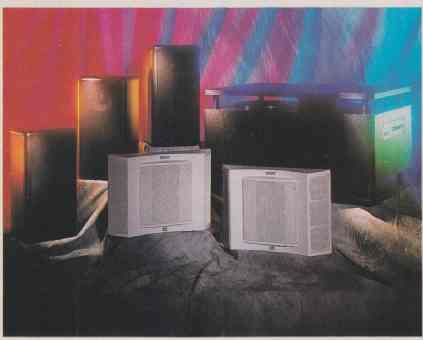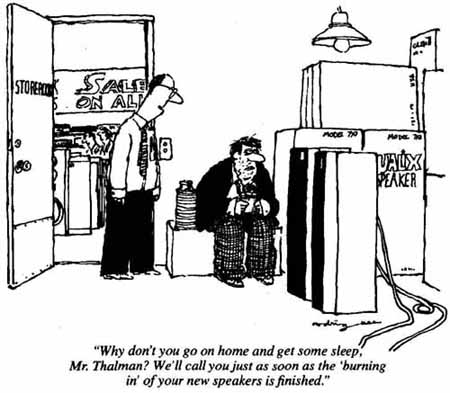
Like other products bearing the Lucasfilm Home THX licensing logo, Altec Lansing’s
$3,000 Home THX speaker system is de signed as part of a comprehensive solution
to the problems of reproducing surround-sound movies at home. Its various components
are available separately, but they will work best together or at least in con
junction with other Home THX speakers. And though it is not essential that
the components ahead of the speakers be THX certified, it can be beneficial,
especially in the case of the surround- sound decoder. The full Altec system
consists of six components: three satellites used as left, center, and right
front speakers, two surround speakers, and a powered subwoofer.
Each of the AHT-2200 satellites ($300 apiece) has two 5¼-inch long throw woofers with carbon-filled poly propylene cones. They crossover at 2.5 kHz to two ½-inch dome tweeters, all in a vertical array. Average impedance is stated as 4 ohms and sensitivity as 89 dB sound-pressure level (SPL) at 1 meter from a 1-watt input. Altec specifies the lower limit of their response as 70 Hz, which means that these satellites should be used with a subwoofer for proper low-frequency balance. Made of high-impact black or white plastic, the enclosures measure 7 7/8 inches wide, 15¾ inches high, and 7 inches deep and weigh 10 pounds. As the manual understates it, they “probably cannot be supported by screws in plaster board.” Expansion anchors are recommended.
As required by Home THX design specs, the front satellites have fairly restricted vertical dispersion. Al though this characteristic makes for very precise imaging and unusual clarity of dialogue reproduction (the main reasons for the dispersion restriction), it also virtually requires that the speakers be at ear level, or, if they are not at ear level, that they be tilted to aim at the ears, in order for the listener to hear their fairly flat on-axis frequency response (also controlled—but not particularly tightly—by Home THX specs). Otherwise, the sound will tend to be somewhat dull. So you should not attempt to judge the Altec Home THX system’s sound quality if the satellites are not at ear level. Departures from this rule, particularly in the case of the center speaker, are not catastrophic— just less than ideal sonically.
Weighing in at 13 pounds apiece, the AHT-2 100 surrounds ($900 a pair) also require some care in installation if you choose to mount them on walls. They actually look best mounted in-wall, for which brackets are provided. The reason they weigh so much is that each AHT-2 100 contains eight drivers in its 15-3/8 x 11 x 6¼-inch plastic enclosure: two front-panel 4-inch long-throw woofers, four 3 1/2-inch woofers split into pairs on the angled side panels, and one ¾-inch dome tweeter on each of the side panels. Rated sensitivity and impedance are the same as for the front satellites.
When the surrounds are mounted to the sides of the listening position, the side-panel drivers fire toward the front and back of the room. The front tweeters operate out of phase with the rear tweeters in a quasi-dipole configuration that reduces the amount of sound radiated directly toward the listener. What you hear from the surrounds therefore consists primarily of reflections, yielding a more diffuse sound than you would get from conventional speakers. The intention here is to envelop the listener in the sound, much as happens in a movie theater with its multiple surround speakers.
The AHT-2300 subwoofer ($1,200) tips the scale at a hefty 85 pounds and is obviously intended for floor placement. But it has no wheels, and moving it over a carpeted floor while looking for a sonically good location to install it wasn’t easy. It is also a rather large piece of furniture, measuring 14 1/2 x 19 x 27 inches, so it will be difficult to hide behind a sofa. It is very sturdy, however, and I imagine that you could safely put a large plant on it or use it as an end table.
In addition to its robust wooden construction, the subwoofer’s weight comes from its two woofers, both with 10-inch cones made of woven carbon fiber, and from its 100-watt Class B power amplifier. The amplifier accepts both line-level and speaker-level inputs via phono-jack and push connectors, respectively. The connectors are located, inconveniently, on the bottom of the enclosure, from which also emerges a too-short power cord.
There are two indicator lights on the subwoofer control panel. One is for power (the amplifier turns on automatically when fed an audio signal). The other is for the dynamic level-control circuit, which prevents the subwoofer from being driven into excessive distortion at very high levels; when the circuit becomes active, the light goes out. When turned on but fed no signal, the subwoofer emits a very quiet rumble/rushing noise, but it is inaudible once you start playing anything. The subwoofer controls include a volume knob and an equalizer dial that raises and lowers the output around 100 Hz. There is a crossover-frequency switch with 50-, 80-, and 100-Hz settings plus a special THX position. One of the two pushbuttons on the panel selects between crossover slopes of 18 and 24 dB per octave. The other enables you to reverse the subwoofer’s phase when that is necessary to achieve a good blend with the main speakers. All of these controls have specific Home THX settings. I used those settings for my listening tests, which were con ducted, at least at the start, with the speakers fed from the amplified out puts of a Home THX “controller” (a component providing both surround- sound-decoder and preamp functions).
The tests demonstrated that the Altec Home THX speaker system was very successful at what it was primarily designed for: soundtrack reproduction. With adventure-movie or space-opera soundtracks, the feeling was of immense reserves of effortless power, a sensation produced only by systems incorporating a true subwoofer. Even when playing at levels that to my ears were excessively loud, the sub- woofer’s dynamic level-control light never extinguished. (The “re-equalization” introduced by the Home THX controller also helped reduce harshness on high-volume sound tracks.) When I listened from the prime location (on the center line be tween the speakers), imaging was extremely precise, and the dipole surrounds produced an all-enveloping ambience as intended. Listening off- center, I found the imaging less precise, but the frequency balance remained very good.
Given their superb performance re producing soundtracks in a full Home THX system, for which these speakers were optimized, I was particularly interested in seeing how they would fare under less than ideal but very common conditions: standard Dolby Pro Logic decoding and plain music listening. So I connected the speakers to a 75-watt A/V receiver containing an appropriately garden-variety Dolby Pro Logic decoder. In such a setup, you give up the harshness-taming Home THX re-equalization and the ambience-spreading surround-output “decorrelation.” But, given those limitations, the Altec speakers still per formed admirably, proving fully the equal of other, non-THX home theater speakers, with the added benefit of their sound-spreading quasi-dipole surrounds.
Altec’s Home THX system also did very well with music. Having a subwoofer capable of substantial output below 30 Hz proved its worth with pipe-organ recordings. The ability of the subwoofer and satellites to play loud particularly benefited the drums in well-recorded jazz CD’s. And the restricted vertical radiation of the satellites, along with their fairly flat frequency response, virtually guaranteed pinpoint left-right imaging for all kinds of music.
But flat-response, restricted-dispersion speakers, like the Altec satellites, tend to be brutally revealing of problems in recordings. If the music is poorly equalized, if the vocals were recorded with non-flat mikes (more the rule than the exception), if the recorded ambience lacks depth, if there is no “air” around the strings, if the producer left a “hole” in the center of his stereo mix, the Altec Home THX system won’t do anything to conceal them. You’ll hear all these defects in their naked splendor, uncloaked by room reflections or a pleasantly colored response. A good multiple-echo ambience-enhancement system can help immensely here with music, and it’s unfortunate that at this stage only one Home THX controller (the Lexicon CP-3) is equipped with one.
I consider such “analytical” reproduction desirable in a loudspeaker, but you may not. To find out, I urge you to audition the Altec Home THX speakers, especially if they are to end up as your primary speaker system. There can be little doubt, however, that a properly installed Altec Home THX speaker system will deliver immense quantities of the often promised but not always delivered excitement of home theater. These are probably the best speakers Altec Lansing has ever produced.

--- (cartoon) “Why don’t you go on home and get some sleep, Mr. Thalman?
We’ll call you just as soon as the ‘burning in’ of your new speakers is finished.”
Source: Stereo Review (Jan. 1994) BY DAVID RANADA